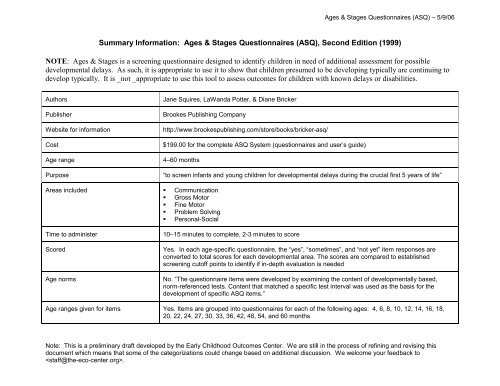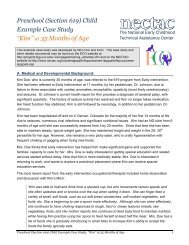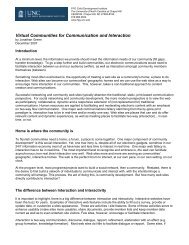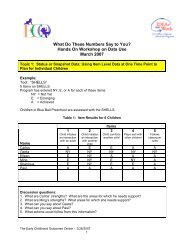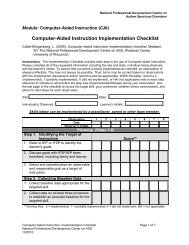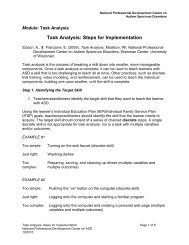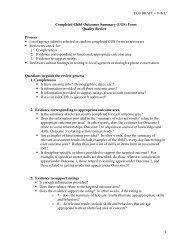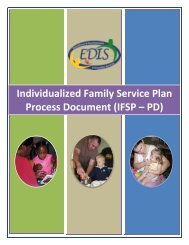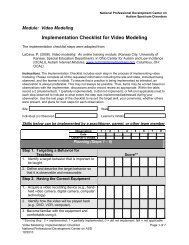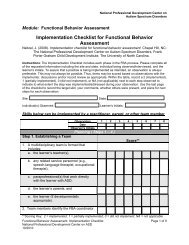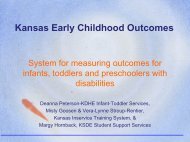Summary Information: Ages & Stages Questionnaires - FPG Child ...
Summary Information: Ages & Stages Questionnaires - FPG Child ...
Summary Information: Ages & Stages Questionnaires - FPG Child ...
You also want an ePaper? Increase the reach of your titles
YUMPU automatically turns print PDFs into web optimized ePapers that Google loves.
<strong>Ages</strong> & <strong>Stages</strong> <strong>Questionnaires</strong> (ASQ) – 5/9/06<br />
<strong>Summary</strong> <strong>Information</strong>: <strong>Ages</strong> & <strong>Stages</strong> <strong>Questionnaires</strong> (ASQ), Second Edition (1999)<br />
NOTE: <strong>Ages</strong> & <strong>Stages</strong> is a screening questionnaire designed to identify children in need of additional assessment for possible<br />
developmental delays. As such, it is appropriate to use it to show that children presumed to be developing typically are continuing to<br />
develop typically. It is _not _appropriate to use this tool to assess outcomes for children with known delays or disabilities.<br />
Authors<br />
Publisher<br />
Website for information<br />
Cost<br />
Age range<br />
Purpose<br />
Jane Squires, LaWanda Potter, & Diane Bricker<br />
Brookes Publishing Company<br />
http://www.brookespublishing.com/store/books/bricker-asq/<br />
$199.00 for the complete ASQ System (questionnaires and user’s guide)<br />
4–60 months<br />
“to screen infants and young children for developmental delays during the crucial first 5 years of life”<br />
Areas included Communication<br />
Gross Motor<br />
Fine Motor<br />
Problem Solving<br />
Personal-Social<br />
Time to administer<br />
Scored<br />
Age norms<br />
10–15 minutes to complete, 2-3 minutes to score<br />
Yes. In each age-specific questionnaire, the “yes”, “sometimes”, and “not yet” item responses are<br />
converted to total scores for each developmental area. The scores are compared to established<br />
screening cutoff points to identify if in-depth evaluation is needed<br />
No. “The questionnaire items were developed by examining the content of developmentally based,<br />
norm-referenced tests. Content that matched a specific test interval was used as the basis for the<br />
development of specific ASQ items.”<br />
Age ranges given for items Yes. Items are grouped into questionnaires for each of the following ages: 4, 6, 8, 10, 12, 14, 16, 18,<br />
20, 22, 24, 27, 30, 33, 36, 42, 48, 54, and 60 months<br />
Note: This is a preliminary draft developed by the Early <strong>Child</strong>hood Outcomes Center. We are still in the process of refining and revising this<br />
document which means that some of the categorizations could change based on additional discussion. We welcome your feedback to<br />
.
<strong>Ages</strong> & <strong>Stages</strong> <strong>Questionnaires</strong> (ASQ) – 5/9/06<br />
<strong>Summary</strong> <strong>Information</strong> (Continued): <strong>Ages</strong> & <strong>Stages</strong> <strong>Questionnaires</strong> (ASQ), Second Edition (1999)<br />
How frequently it can be given<br />
Standardized tasks<br />
Based on observation in natural<br />
settings<br />
Instructions related to parent role<br />
<strong>Questionnaires</strong> are designed to be completed at specific ages (see above). Each questionnaire is valid<br />
for one month before and one month after the indicated age<br />
No<br />
Yes<br />
Yes. Parents complete questionnaires<br />
Data provided on reliability Yes. Test-retest reliability = 90% agreement; interrater reliability = 90%<br />
Data provided on validity Yes. Validity data collected using 1,763 assessments; overall agreement = 83% with a range of 76%-<br />
91%<br />
Web-based data entry<br />
Electronic scoring<br />
Other languages<br />
Who administers<br />
Training available through the<br />
publisher<br />
No. “ASQ Manager,” a computerized database program for individual children’s records is under<br />
development<br />
No. The “ASQ Manager tabulates scores, identifies areas in which the child needs further assessment,<br />
formats questionnaire information into a printable document for sharing with parents, and generates a<br />
letter to the parents explaining the results. The program can also generate reports of all children in the<br />
center, helping users identify which children need to be screened on a month by month basis, which<br />
children need follow-up assessment, etc.”<br />
Spanish, French, and Korean. Other languages under development<br />
Parents<br />
Yes<br />
Note: This is a preliminary draft developed by the Early <strong>Child</strong>hood Outcomes Center. We are still in the process of refining and revising this<br />
document which means that some of the categorizations could change based on additional discussion. We welcome your feedback to<br />
.<br />
2
<strong>Ages</strong> & <strong>Stages</strong> <strong>Questionnaires</strong> (ASQ, 1999): Crosswalk to <strong>Child</strong> Outcomes<br />
<strong>Ages</strong> & <strong>Stages</strong> <strong>Questionnaires</strong> (ASQ) – 5/9/06<br />
NOTE: <strong>Ages</strong> & <strong>Stages</strong> is a screening questionnaire designed to identify children in need of additional assessment for possible developmental<br />
delays. As such, it is appropriate to use it to show that children presumed to be developing typically are continuing to develop typically. It is not<br />
appropriate to use this tool to assess outcomes for children with known delays or disabilities.<br />
Outcome 1<br />
Positive social relationships<br />
Communication<br />
Outcome 2<br />
Knowledge and skills<br />
• Babbling, vocalizing, listening,<br />
understanding<br />
• Questions ask, for example, if a child makes<br />
sounds, repeats sounds, says syllables,<br />
follows simple command, says one word,<br />
points to objects, says two-word sentences,<br />
names pictures, carries out three directions,<br />
makes three-word sentences, describes<br />
action pictures, answers questions, uses<br />
grammar, uses comparison words<br />
Problem solving<br />
• Learning and playing with toys<br />
• Questions ask, for example, if a child tracks<br />
objects with eyes, mouths toys, bangs toys,<br />
finds hidden toys, uses a tool to get<br />
something out of reach, imitates action,<br />
pretends objects are something else, names<br />
colors, counts<br />
Gross motor*<br />
Outcome 3<br />
Action to meet needs<br />
• Arm, body, leg movements<br />
• Questions ask, for example, if a child holds<br />
head up, crawls, rolls, balances, climbs onto<br />
furniture, walks, runs, walks down stairs,<br />
jumps, climbs a ladder, catches a ball, walks<br />
on tiptoe, skips<br />
Fine motor*<br />
• Hand and finger movements (as<br />
summarized in the user’s guide)<br />
• Questions ask, for example, if a child holds<br />
toys, reaches, picks up toys, makes a<br />
crayon mark, throws a ball, stacks blocks,<br />
turns pages, screws lids on and off, threads<br />
shoelaces, draws a circle, tries to cut paper,<br />
puts together puzzles, traces with a pencil,<br />
copies letters<br />
Personal-social<br />
• Items associated with self care such as<br />
feeding self, drinking from a cup, dressing,<br />
getting attention/help, combing hair, eating<br />
with a fork, dressing self, washing face,<br />
brushing teeth, giving personal information<br />
*Precursor skills for functional behaviors. These skills may not be appropriate or expected for some children, including those with sensory motor,<br />
or other impairments.<br />
Note: This is a preliminary draft developed by the Early <strong>Child</strong>hood Outcomes Center. We are still in the process of refining and revising this<br />
document which means that some of the categorizations could change based on additional discussion. We welcome your feedback to<br />
.<br />
3


